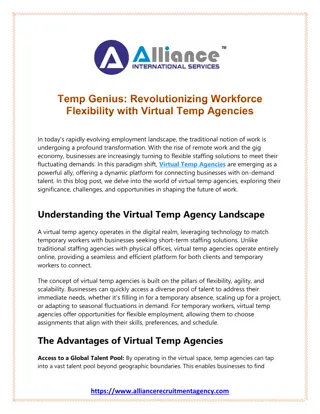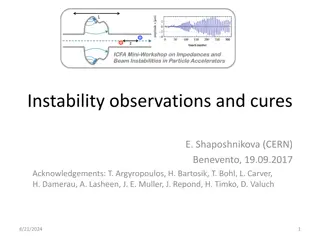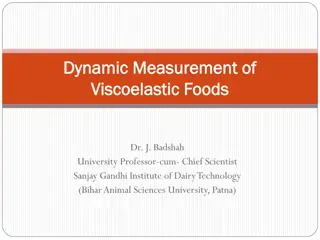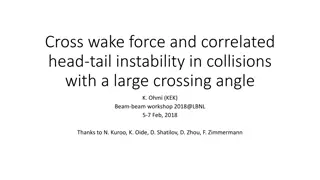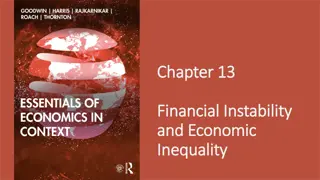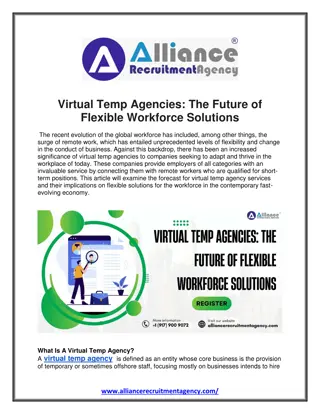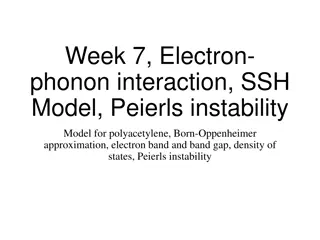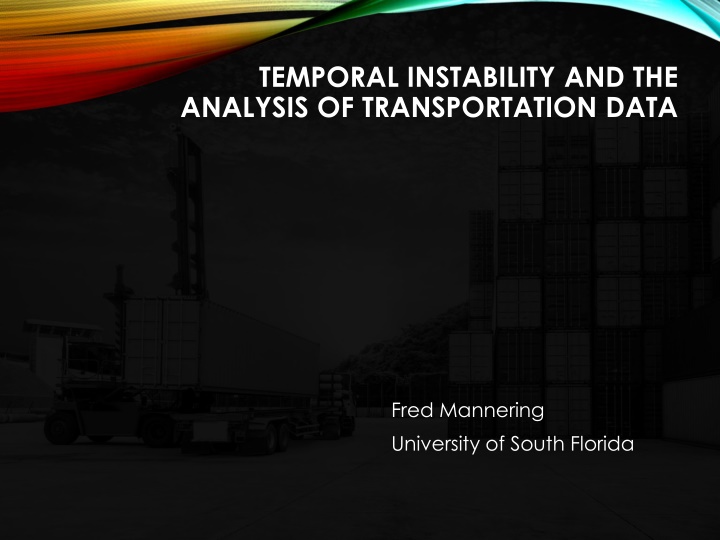
Analyzing Transportation Data for Temporal Instability Trends
Explore the impact of temporal instability on transportation data analysis, focusing on models of human behavior, safety analytics, evolution of behavior in highway accidents, and upcoming safety technologies like autonomous vehicles. Delve into historical accident data analysis and the challenges of addressing long-term phenomena affecting highway safety.
Download Presentation

Please find below an Image/Link to download the presentation.
The content on the website is provided AS IS for your information and personal use only. It may not be sold, licensed, or shared on other websites without obtaining consent from the author. If you encounter any issues during the download, it is possible that the publisher has removed the file from their server.
You are allowed to download the files provided on this website for personal or commercial use, subject to the condition that they are used lawfully. All files are the property of their respective owners.
The content on the website is provided AS IS for your information and personal use only. It may not be sold, licensed, or shared on other websites without obtaining consent from the author.
E N D
Presentation Transcript
TEMPORAL INSTABILITY AND THE ANALYSIS OF TRANSPORTATION DATA Fred Mannering University of South Florida
TRANSPORTATION MODELING AND TEMPORAL INSTABILITY Commonly used models of human behavior, travel demand and highway safety inherently assume estimated model parameters are stable over time ( s do not change) But is it correct in assuming the effect of explanatory variables are constant over time?
SAFETY ANALYTICS AND TEMPORAL INSTABILITY Technologies associated with safety are likely to significantly alter human behavior Human behavior will now be influenced by: The underlying evolution of behavior The effect of technology and its interaction with evolutionary forces
EVOLUTION OF BEHAVIOR: THE CASE OF HIGHWAY ACCIDENTS Cost the lives of more than 1.2 million people per year An estimated 50 million more injured Safety researchers have sought for decades to reduce this carnage with the statistical analysis of accident data
WHAT IS COMING IN SAFETY: Autonomous vehicles mixed with human- driven vehicles Connected vehicle communication Vehicle to everything communication
Studies have focused on analyzing the likelihood of an accident and its resulting injury severity HISTORICAL ANALYSIS OF HIGHWAY ACCIDENT DATA: Important insights have been made
However, safety analysts have struggled addressing two longer-term phenomena: 1. The general downward trend in fatalities per distance driven, and 2. The fact that fatalities per distance driven tend to decline in economic downturns and increase in economic upturns.
THE GENERAL DOWNWARD TREND IN FATALITIES PER DISTANCE DRIVEN: Improved vehicle-safety technologies, Improved highway design, Impaired driver enforcement, Driver/public education programs But what about the effect of possibility temporally changing behavior?
FATALITY DECLINES IN ECONOMIC DOWNTURNS/ INCREASES IN ECONOMIC UPTURNS: Changes in discretionary driving patterns Changes in values of time Changes in the distances risky versus safe drivers drive But what about the possible effect of temporally changing behavior induced by economics?
Human behavior may be evolving and thus fundamentally changing over time a change that may be in response to short-term macroeconomic conditions and other time-varying influences THE ALTERNATIVE EXPLANATION: TEMPORAL INSTABILITY There is a vast body of literature from psychology, neuroscience, economics, cognitive science and other fields that suggests such a temporal element Temporal instability has profound implications for traditional statistical analyses and even AI/ML
TEMPORAL CONSIDERATIONS ARE IMPORTANT BECAUSE THERE IS NO TRUE CROSS-SECTIONAL ACCIDENT DATA Accidents are such rare events that data are gathered over weeks, months or even years to get enough observations Thus, temporal instability is problematic in all traditional accident-data analyses
Numerous papers have found temporal instability from 2004 to 2012; before, during and after the 2007-2010 great recession; and virtually every year after 2012. EMPIRICAL EVIDENCE OF And, the Markov-switching model findings in various papers suggests temporal instability in what researchers typically treat as cross-sectional data. TEMPORAL INSTABILITY
Driver decision making is a combination of automatic and controlled processes of the brain and these are evolving over time THE GENERAL CASE FOR TEMPORAL INSTABILITY Controlled and automatic processes evolve over time based on accumulated driver experiences, etc. Accident research attempts to capture this evolution with variables such as age and driver- experience variables while accounting for potential unobserved heterogeneity
CAUSES OF TEMPORAL INSTABILITY Decision making and cognitive processes that change in eras of rapidly changing vehicle technologies (autonomous vehicle technologies), social media, and other forms of information gathering Effects of macroeconomics on risk-taking Evolving attitudes and behavior
ROLE OF CHANGING VEHICLE TECHNOLOGIES Traditional safety features (antilock brakes, electronic stability control, etc.) Advanced safety features (autonomous braking, adaptive cruise control, etc.) Introduction of autonomous vehicles
ROLE OF MACROECONOMICS AND RISK-TAKING BEHAVIOR Literature shows: Investment and return experiences from decades ago affect financial risk-taking Current macroeconomic conditions affect financial risk taking Significant positive correlation between financial risk taking and risky driving
ROLE OF ATTITUDES AND BEHAVIOR Individuals continuously gather information from driving, observing others driving, social media, government reports, advertisements, etc. This information is constantly forming and altering attitudes and behavior regarding safety
ROLE OF ATTITUDES AND BEHAVIOR (CONT.) But the relationship between attitudes and behavior can be tenuous Differences between attitudes and behavior creates a cognitive dissonance (Leon Festinger, 1962) which individuals continually seek to reconcile This suggests the relationship between attitudes and behavior is inherently unstable over time
DISSONANCE BETWEEN ATTITUDES AND BEHAVIOR: Attitudes Behavior Time 1 Time 2 Time 3 Time 4
NON-SAFETY EXAMPLE AUTONOMOUS VEHICLES The effect of information on changing opinions toward autonomous vehicle adoption (Sheela and Mannering 2020) A) Individuals state their preference on adoption; B) are provided information C) then restate their preference Preferences change significantly, including polarization as people seek to confirm their initial opinions by selectively processing information
TEMPORAL INSTABILITY AND CURRENT TRANSPORTATION DATA ANALYSIS METHODS Heterogeneity models Data-driven approaches (AI/ML) Traditional safety models (Highway Safety Manual) Causal-inference models
UNOBSERVED HETEROGENEITY MODELS AND TEMPORAL INSTABILITY Random parameters, latent class, Markov switching, etc. Unobserved heterogeneity has been attributed it to potential unobserved variations in factors such as human behavior, human physiology, vehicle characters, roadway characters, and weather But what if heterogeneity models are capturing temporal instability?
EXAMPLE 1 Consider a count data model that looks at the number of accidents per year across highway segments If the effects of explanatory variables are globally changing over the observation year, a highway segment having more of its accidents early in the year may have different parameter values than a highway segment that has more of its accidents later in the year The analyst will not be able to distinguish this temporal effect from true unobserved heterogeneity
EXAMPLE 2 Consider an injury severity model of crashes on a highway segment over a year Finding statistically significant unobserved heterogeneity (such as significant parameter variances for one or more explanatory variables in a random parameters model) could be entirely due to temporal shifts Or, more likely, a combination of temporal shifts and other traditional sources of unobserved heterogeneity
DATA-DRIVEN MODELS AND TEMPORAL INSTABILITY Machine learning: Neural networks, decision trees, support vector machines, deep learning and others Big-data Models Can potentially track existing data very well, but they do not provide guidance for how the results may shift over time
TRADITIONAL SAFETY MODELS AND TEMPORAL INSTABILITY Often estimate count and severity models with limited data (because of practical data availability and being useful to practitioners) Apply empirical Bayes approach to evaluate the before and after effect of safety interventions In the presence of temporal instability, traditional safety models, and their potential application in Bayesian before and after analyses, can potentially be problematic
CAUSAL-INFERENCE MODELS AND TEMPORAL INSTABILITY One potential problem that has not yet been adequately addressed in the analysis of highway accident data: Those involved in accidents may be a non-random sample of the motoring public (less-safe drivers will be over- represented in accident data) Can result in erroneous interpretation of findings
THE SELECTIVITY PROBLEM ALSO EXTENDS TO REAL-TIME DATA COLLECTION: Drivers observed at intersections or roadway segments self-select as part of their route-choice decisions For example, safe drivers may select routes to avoid dangerous intersections
EXAMPLE Consider a motorcyclist injury- severity model that finds rain increases injury severity But the sample of motorcyclists choosing to ride in the rain is a self- selected group, possibly of riskier riders So how much of the effect of the rain variable is due to rain and how much is due to the non- random sample of riders riding in the rain?
MOTORCYCLE SAFETY POLICY PROBLEM: Do you mandate improved braking (ABS), wet traction friction tires, etc.? Or, do you have a public safety campaign about the dangers of riding in wet conditions?
CAUSAL INFERENCE APPROACH: Causal-inference models address this possibility by controlling for factors relating to self selectivity (using riders observed in both dry and rainy contexts, fixed effects, etc.) The control-variable correction usually involves time-series data However, in the presence of temporal instability, this control variable approach will be highly susceptible to estimation error
ADDRESSING TEMPORAL INSTABILITY 1. Develop a model that tracks the change in estimated parameters over time as a function of explanatory variables: = + T i i Where Ti is a vector of explanatory variables that determine the change in i over time
2. Introduce heterogeneity in the means and variances of parameters as a function of variables that track temporal changes: ( ) = + + EXP T W i i i i i i i Where Ti is a vector of explanatory variables that captures time- dependent heterogeneity in the mean, Wi is a vector of explanatory variables that captures time- dependent heterogeneity in the standard deviation
2. Estimate Markov-switching models where multiple hidden states exist and there is a transition between these states over time For a model with two states: ) 0 1 1 0 t |s p = = = ( ( ) = = = and 0 1 P s , P s |s 1 0 p + + 1 1 t t t Where state transition probabilities and can be estimated from the accident data p p 0 1 1 0 State transitions can also be a function of time-shifting explanatory variables (extremely complex estimation)
SUMMARY AND CONCLUSIONS 1. The temporal elements associated with individual behavior are important factors to consider when developing modeling approaches and interpreting model findings Ignoring these fundamental temporal elements can lead to erroneous conclusions and ineffective or even dangerous safety policies
SUMMARY AND CONCLUSIONS (CONT.) 2. Different data analysis methods (unobserved heterogeneity, data driven, traditional, and causal inference models) can be affected by potential temporal instability in different ways This must be given careful consideration in the interpretation of results
SUMMARY AND CONCLUSIONS (CONT.) 3. For highway safety, the possibility of temporal instability will be much higher in a world of partial autonomous vehicle adoption this has profound implications for current safety practice and allocation of funds for safety improvements
SUMMARY AND CONCLUSIONS (CONT.) 4. While explicitly accounting for temporal elements in current modeling approaches presents a formidable technical challenge, the field must move to address this challenge even if only in an incremental way







